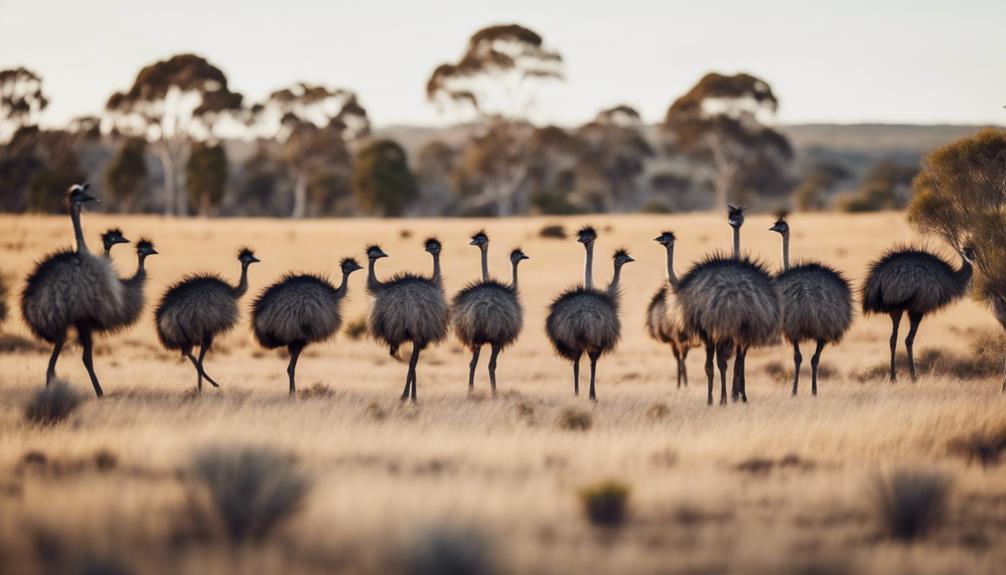
Imagine the vast Australian landscape, where emus roam freely, embodying a symbol of resilience and harmony with nature. These unique birds play a crucial role in shaping the ecosystems they inhabit, influencing various aspects of the environment.
From seed dispersal to soil health, the impact of emus extends far beyond their striking appearance.
As you explore the intricate web of interactions involving emus, you will uncover the intricate ways in which these birds contribute to the delicate balance of Australian ecosystems.
Key Takeaways
- Emus play a crucial role in seed dispersal, aiding in plant regeneration and promoting biodiversity.
- Their foraging behavior influences ecosystem dynamics, preventing plant dominance and supporting habitat restoration.
- Emus contribute significantly to biodiversity through diverse foraging habits and cooperative behaviors.
- They enhance woodland health and soil fertility, shaping biodiversity and ecological dynamics in Australian ecosystems.
Emus as Seed Dispersers
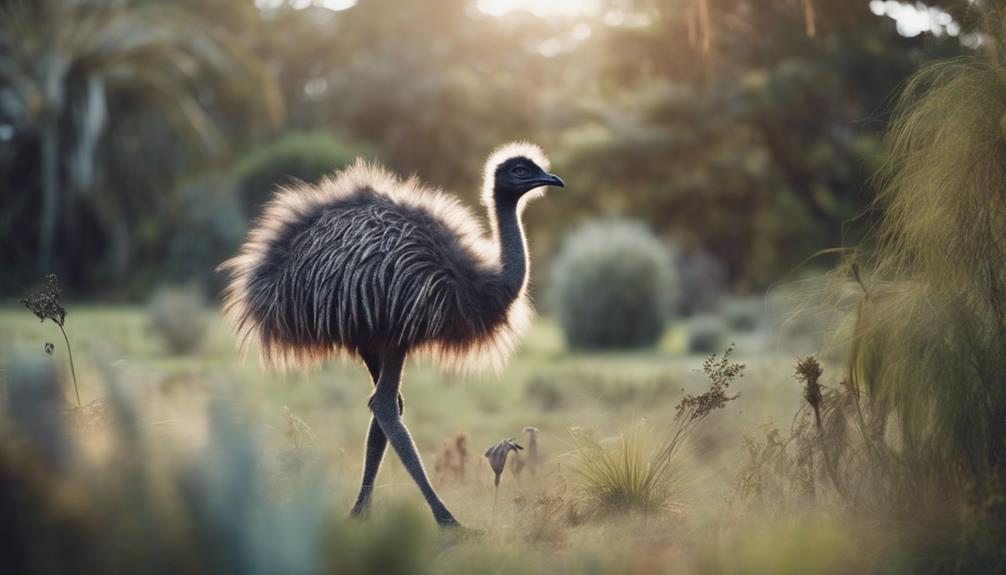
Emus play a crucial role in Australian ecosystems by actively dispersing seeds through their consumption and subsequent movement across vast territories. This behavior significantly contributes to vegetation regeneration and provides essential ecological services. As emus roam the Australian landscape, they consume a variety of seeds, which then pass through their digestive system unharmed. When the emus excrete these seeds along their journey, they're effectively dispersed to new locations, aiding in the replenishment of plant populations across different habitats.
The ecological impact of emus as seed dispersers can't be understated. By facilitating the movement of seeds to diverse environments, emus enhance plant biodiversity and promote the resilience of ecosystems. This process of seed dispersal not only benefits the existing vegetation but also supports the establishment of new plant communities in areas where seeds may not have reached otherwise. Therefore, the role of emus in seed dispersal is vital for the maintenance and sustainability of Australian ecosystems.
Impact on Grasslands
Frequently observed in Australian grasslands, the impact of emus on these ecosystems is a significant factor in shaping their biodiversity and ecological dynamics. Emus are known for their grazing impacts, which play a crucial role in maintaining the balance of plant communities within these habitats. By selectively feeding on certain plant species, emus help prevent the dominance of one plant type, promoting species diversity and overall ecosystem health. Their foraging behavior also aids in controlling vegetation density, which can have cascading effects on other organisms within the grassland environment.
Moreover, emus contribute to habitat restoration in grasslands through their feeding habits. By consuming seeds of various plant species, emus inadvertently aid in seed dispersal, helping to regenerate vegetation in areas where plant cover has been disturbed. This process supports the natural regeneration of grasslands and assists in the recovery of degraded habitats. Overall, the presence of emus in Australian grasslands serves as a vital component in maintaining the ecological balance and preserving the biodiversity of these unique ecosystems.
Role in Woodland Health
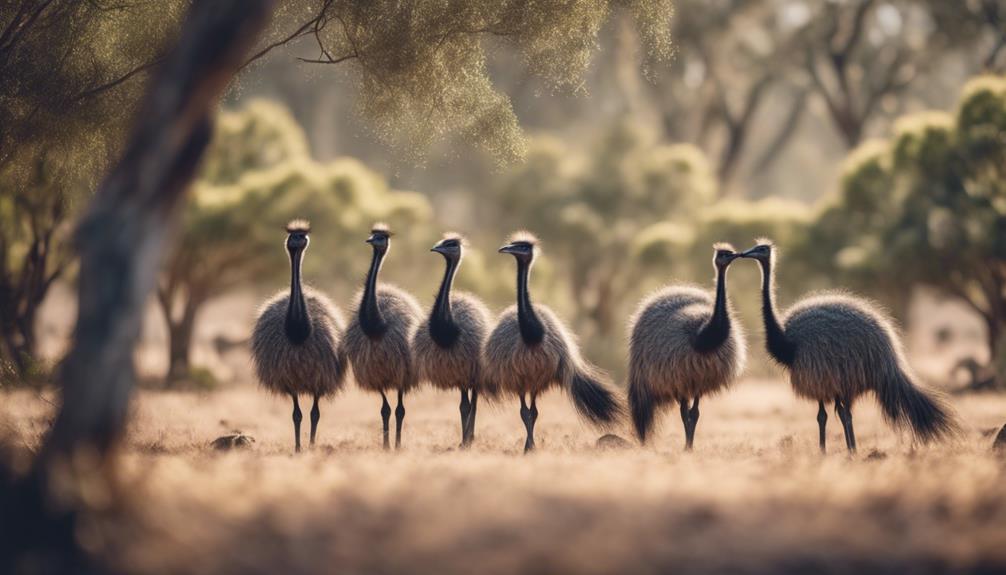
Key players in the maintenance of woodland health, the impact of emus on these ecosystems is a crucial factor in shaping their biodiversity and ecological dynamics. Emus contribute significantly to woodland regeneration by dispersing seeds through their droppings. This process aids in the establishment of a diverse range of plant species, promoting a more resilient and balanced ecosystem. Additionally, emus play a role in controlling vegetation density through their browsing activities, which helps prevent the dominance of certain plant species and allows for a more varied plant community to thrive.
Moreover, the presence of emus influences ecosystem dynamics by affecting nutrient cycling and soil structure. Their foraging behavior can disturb the soil, promoting aeration and nutrient distribution. This disturbance, although seemingly disruptive, contributes to the overall health of the woodland by enhancing soil fertility and supporting microbial activity. Ultimately, the interactions between emus and woodland environments highlight the intricate relationships within these ecosystems, emphasizing the importance of these iconic birds in maintaining ecological balance.
Emu Foraging Behavior
In understanding the influence of emus on woodland ecosystems, it's crucial to examine the intricate dynamics of their foraging behavior. Emus, as large flightless birds, play a significant role in shaping their environment through their feeding habits and social dynamics. Here are some key aspects to consider:
- Feeding Habits: Emus are omnivores with a diverse diet that includes fruits, seeds, insects, and even small vertebrates. Their foraging behavior helps in seed dispersal and nutrient recycling within the ecosystem.
- Social Dynamics: Emus often forage in groups, displaying cooperative behaviors such as alerting each other to potential threats. This social aspect of their foraging behavior can influence their impact on the environment.
- Environmental Impact: The selective feeding habits of emus can affect plant species composition and distribution in their habitat, influencing the overall biodiversity.
- Conservation Efforts: Understanding emu foraging behavior is crucial for implementing effective conservation strategies that consider their role in maintaining ecosystem balance.
Contribution to Biodiversity
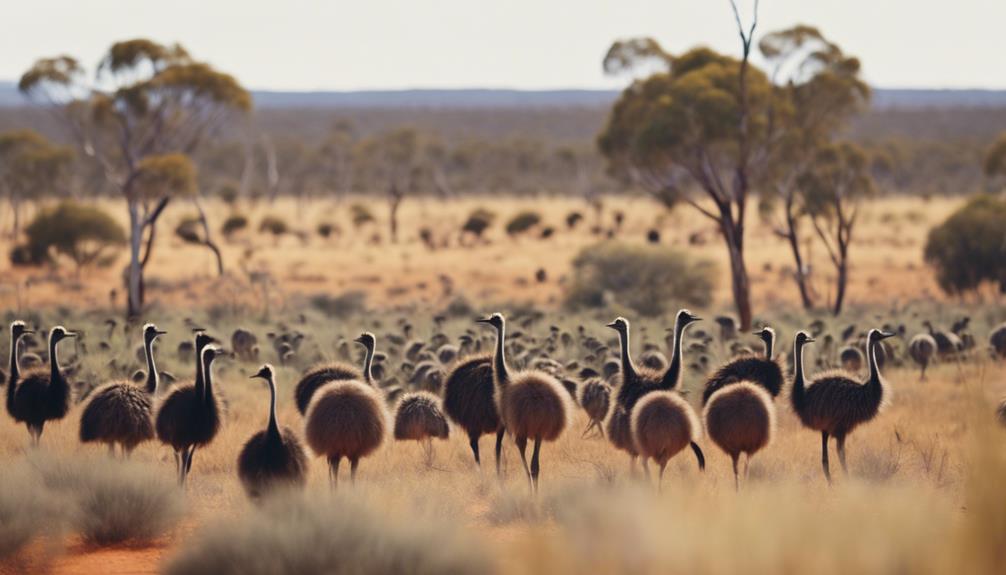
Emus contribute significantly to the biodiversity of Australian ecosystems through their diverse foraging habits and interactions with various plant and animal species. These large flightless birds play a crucial role in shaping species interactions and community dynamics within their habitats. By foraging on a wide range of vegetation, emus help regulate plant populations, which in turn affects the abundance of other species in the ecosystem. Their feeding behavior influences the distribution of seeds, leading to changes in plant composition and diversity.
Moreover, emus also contribute to biodiversity conservation and ecosystem resilience by acting as seed dispersers for many plant species. Through their consumption of fruits and seeds, emus aid in the dispersal of plant propagules across different areas, promoting gene flow and contributing to the overall genetic diversity of plant populations. This process enhances ecosystem stability and adaptability to environmental changes, ultimately supporting the long-term health and sustainability of Australian ecosystems.
Emus and Native Plants
Contributing significantly to the ecosystem, native plants interact with emus in various ways that impact their survival and distribution within Australian habitats. Emus play a crucial role in the pollination of native plants, aiding in the reproduction and genetic diversity of vegetation. Their foraging habits also influence vegetation dynamics by shaping the structure and composition of plant communities. This interaction has ripple effects on other species dependent on these plants for food and habitat.
Ways Emus Impact Native Plants:
- Pollination Assistance: Emus inadvertently aid in the pollination of various native plant species as they move through different habitats.
- Seed Dispersal: Emus help disperse seeds, contributing to the spread and regeneration of plant populations.
- Vegetation Trimming: By feeding on certain plants, emus control the growth of vegetation, impacting plant density and distribution.
- Habitat Modification: Emus create disturbances that can lead to changes in plant succession patterns, influencing the overall ecosystem structure.
Significance in Ecosystems
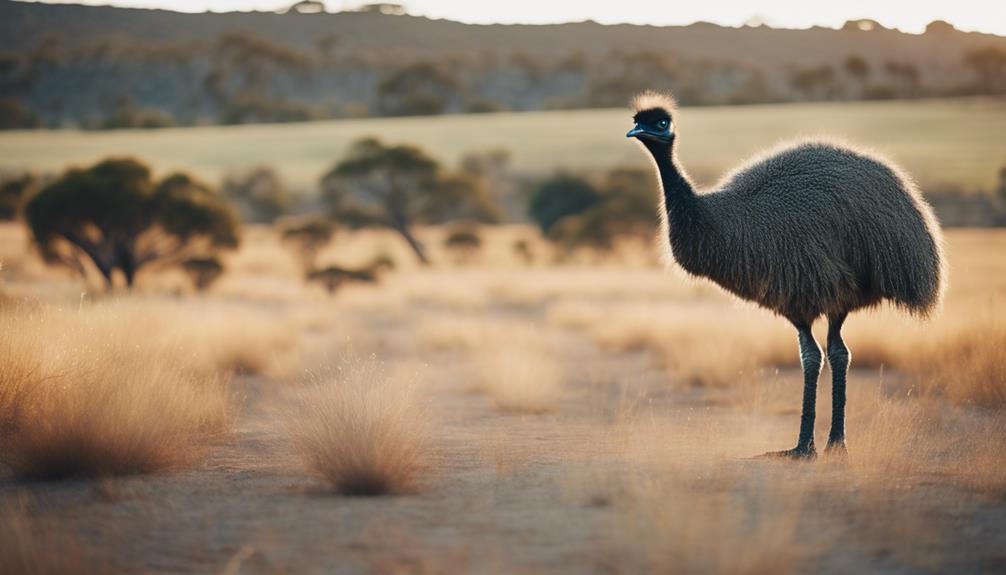
Interactions between emus and native plants in Australian ecosystems highlight the significant role these birds play in shaping the biodiversity and ecological balance of their habitats. Emus, as both predators and competitors, influence predator-prey dynamics and competition within their ecosystems. By foraging on various plant species, emus indirectly impact the distribution and abundance of plant communities, thereby affecting the trophic interactions within the ecosystem.
The presence of emus contributes to ecosystem resilience by regulating plant populations and preventing any one species from dominating the landscape. Through their selective feeding habits, emus help maintain a balanced ecosystem where different plant species can coexist and thrive. This balance is crucial for ensuring the overall health and stability of the ecosystem.
Maintaining Habitat Balance
Maintaining habitat balance in Australian ecosystems is crucial for the overall health and stability of the environment. Effective wildlife management and habitat restoration practices play a vital role in achieving this balance. Here are some key points to consider:
- Biodiversity Preservation: Habitat restoration efforts help preserve the diverse range of plant and animal species that call these ecosystems home.
- Ecosystem Resilience: By maintaining habitat balance, ecosystems can better withstand environmental changes and disturbances, ensuring their long-term survival.
- Population Dynamics: Proper wildlife management strategies help regulate animal populations, preventing overpopulation or extinction of certain species.
- Sustainable Resource Use: Balancing habitats ensures that resources like food, water, and shelter are available for all species, promoting sustainable coexistence.
Emus and Soil Health
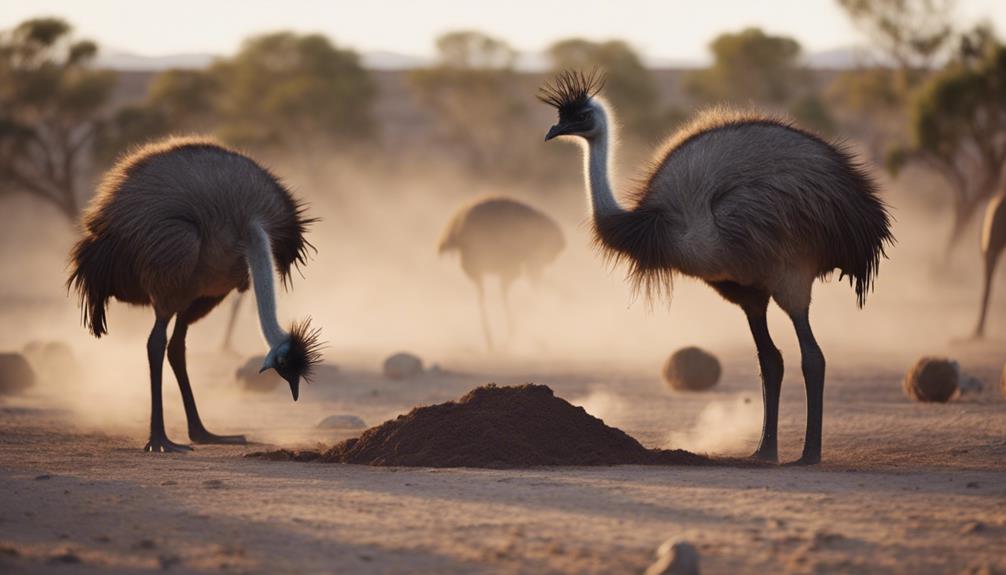
Emus play a significant role in influencing soil health within Australian ecosystems. Their foraging behavior and movement patterns contribute to enhancing soil fertility and nutrient cycling processes. As emus roam across vast territories in search of food, they disturb the topsoil, promoting aeration and breaking down organic matter. This disturbance facilitates the incorporation of organic materials into the soil, increasing nutrient availability for plants and enhancing soil fertility.
Moreover, emus consume a variety of plants and seeds, which influences vegetation composition and density. By regulating plant growth, emus indirectly impact the amount of organic matter returned to the soil through plant litter and root turnover. This, in turn, affects nutrient cycling rates and soil structure. Emus also aid in seed dispersal, promoting plant diversity and ecosystem resilience.
Interactions With Other Species
By foraging on a diverse range of plants and seeds, emus inadvertently influence the composition and distribution of vegetation in Australian ecosystems. This behavior not only impacts the plant life but also plays a crucial role in shaping interactions with other species.
- Predator-Prey Dynamics: Emus, as large flightless birds, serve as prey to predators like dingoes and eagles. Their presence influences the predator-prey dynamics within the ecosystem.
- Symbiotic Relationships: Emus have symbiotic relationships with certain plant species, aiding in seed dispersal through their consumption and subsequent excretion in different locations. This process contributes to the regeneration and genetic diversity of plant populations.
- Competition with Herbivores: Emus compete with other herbivores such as kangaroos and wallabies for food resources, affecting the balance of herbivore populations in the ecosystem.
- Impact on Insect Populations: By altering the vegetation structure through their foraging habits, emus indirectly influence insect populations, creating a ripple effect throughout the food web.
Understanding the multifaceted interactions between emus and other species is essential for comprehending the intricate dynamics of Australian ecosystems.
Ecological Importance of Emus
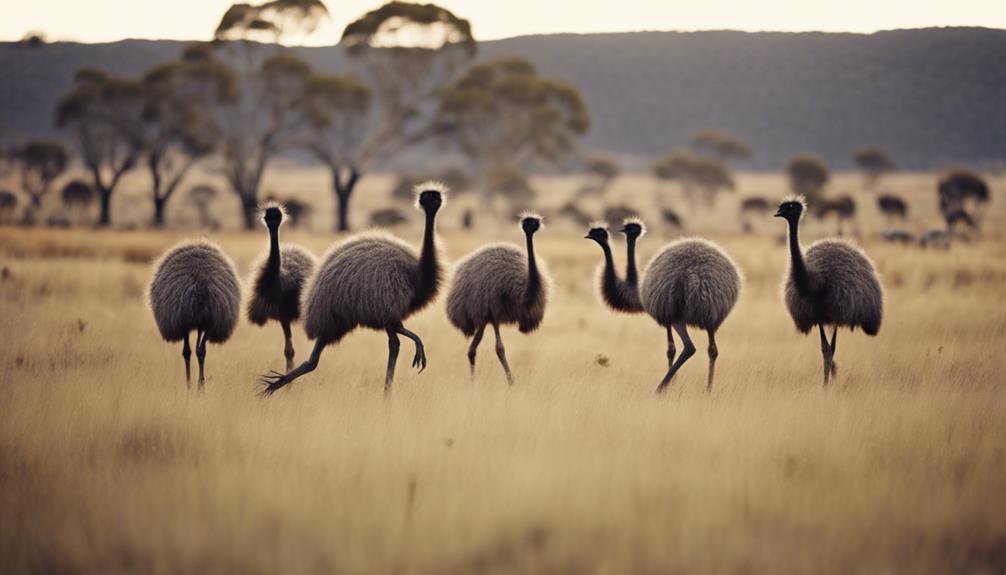
In the intricate web of Australian ecosystems, the ecological importance of emus emerges as a significant factor in shaping the dynamics of plant and animal interactions. Emus play a crucial role as predators in these ecosystems, impacting the population dynamics of various species. Their foraging habits influence vegetation growth and distribution, creating cascading effects on other herbivores and ultimately shaping the landscape.
| Emus as Predator | Emu Population Dynamics | Relationship with Other Species |
|---|---|---|
| Control insect populations | Impact breeding success | Compete with kangaroos for food |
| Reduce plant overgrowth | Influence species diversity | Aid in seed dispersal |
| Maintain ecosystem balance | Respond to climate changes | Support fox and cat control efforts |
Understanding the intricate relationship between emus and their environment is essential for effective conservation strategies. By recognizing the ecological significance of emus as both predators and influencers of ecosystem dynamics, researchers can better assess the overall health and resilience of Australian ecosystems.
Conservation Implications
The conservation implications stemming from the role of emus in Australian ecosystems are vital for maintaining biodiversity and ecosystem resilience. Emus play a crucial role in predator-prey dynamics, influencing the population sizes of various species through their foraging habits and interactions with other animals. Understanding these dynamics is essential for effective conservation efforts to protect the delicate balance within the ecosystem.
Emu population dynamics are closely linked to habitat restoration initiatives, as the availability of suitable habitats directly impacts their numbers and distribution. Conservation efforts aimed at preserving emu habitats not only benefit the species itself but also contribute to the overall health of the ecosystem. By considering the intricate relationships between emus and their environment, conservationists can develop targeted strategies to safeguard these iconic birds and the biodiversity they support.
Frequently Asked Questions
How Do Emus' Reproductive Habits Contribute to the Overall Health of Australian Ecosystems?
When emus reproduce, their behavior affects the delicate balance of Australian ecosystems. By nesting on the ground, they create disturbances that influence plant growth and soil health, ultimately contributing to the overall health and diversity of the ecosystem.
Are There Any Specific Plant Species That Heavily Rely on Emus for Seed Dispersal and Regeneration?
When it comes to seed dispersal and regeneration, some plant species heavily rely on emus for their survival. This unique emu interaction ensures the dispersal of seeds that are crucial for the regeneration of specific plant populations in Australian ecosystems.
How Do Emus' Movements and Migration Patterns Affect the Distribution of Plants and Animals in Their Habitat?
When emus roam and migrate, they shape their habitat, influencing plant and animal distribution. Their movements can lead to habitat fragmentation, impacting species competition. Understanding these dynamics is crucial for biodiversity conservation and enhancing ecosystem resilience.
Do Emus Play a Role in Controlling Invasive Species or Pests Within Australian Ecosystems?
Emus play a vital role in controlling invasive species and pests within Australian ecosystems through their predation behaviors. Their grazing activities also contribute to vegetation management, influencing the distribution and abundance of plant species.
Are There Any Potential Negative Impacts of Emus on Certain Plant or Animal Populations Within Their Ecosystems?
In some instances, emu predation on certain plant species can impact vegetation growth, leading to habitat destruction. Overgrazing by emus may also pose competition for resources, affecting other herbivores in the ecosystem.
Conclusion
In conclusion, emus play a vital role in Australian ecosystems as key seed dispersers, influencers of grassland health, and contributors to biodiversity.
Like a symphony conductor orchestrating a harmonious performance, emus act as ecological stewards, shaping the landscape and enhancing soil health.
Understanding and protecting their role in the ecosystem is crucial for maintaining the delicate balance of Australia's unique flora and fauna.




